This was published 6 years ago
Isle of Mull, Scotland: At Duart Castle, you get a personal clan chief greeting
By Steve Meacham
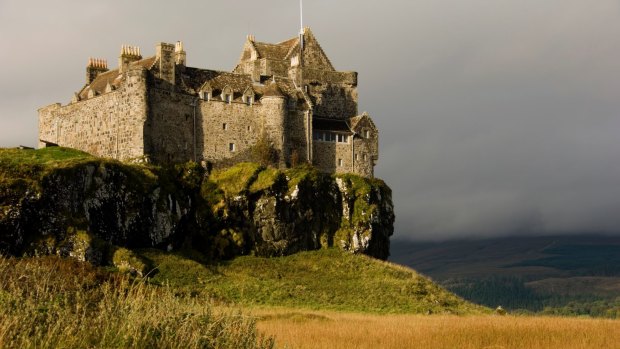
Duart Castle on the island of Mull, Scotland.
"We've always been Jacobite, which means we usually ended up on the losing side," says Sir Lachlan MacLean, 28th chief of the Clan MacLean, as he welcomes us to Duart Castle – home of the MacLeans, McLeans, Macleans and every other variation of that surname for the past 600 years.
Being greeted by the aristocratic owner of a British stately "pile" isn't something you normally expect. Especially when he's in his 70s and it's decidedly chilly on the Isle of Mull despite it being a late spring morning.
But Sir Lachlan is often to be found guiding visitors around the imposing fortress that has been the clan's headquarters for all these centuries.
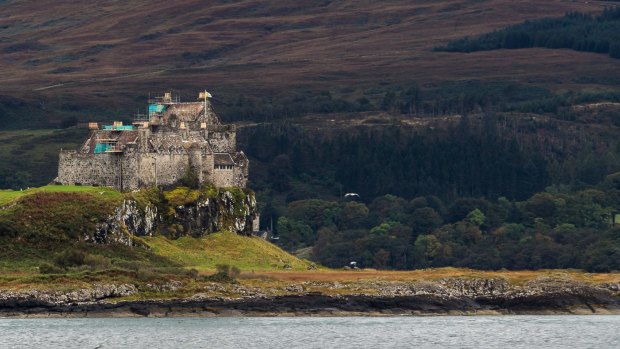
Duart Castle, Mull, Scotland.Credit: iStock
And if he's not on greet-and-meet, he might be serving the MacLean's traditional whisky and honey cake in the former cattle byres (now converted to a charming cafe-gift shop).
"He's Scottish," one cynic in our party says. "He's just trying to save on staff costs," when I say I'm impressed he has made such an effort.
And yes, the clan chief readily admits he's "thrifty". He's wearing "trewsers" made of the rather flamboyant green "Maclean Hunting Tartan". "My wife bought three pairs of these at a healthy discount," he says.
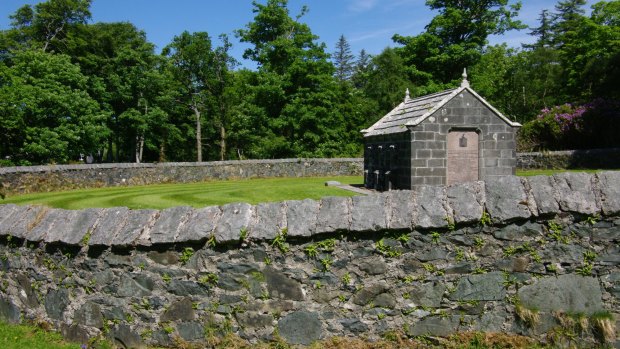
Macquarie Mausoleum, Gruline, Isle of Mull, Scotland. Credit: Alamy
But you can't knock the fact that he's here, maintaining one of Scotland's most scenic castles, and keeping it in good repair for all the other "MacLeans" who want one day to visit their ancestral "home".
"It is a considerable duty," Sir Lachlan says. "When I told my daughter that I was moving here permanently – even though the castle has no heating and, in winter, it gets dark around 3pm – she said: 'But, Daddy, you're already an alcoholic! How will you cope?' "
Whisky does help, he jokes. But the scaffolding wrapped around much of the castle shows how soberly he continues the task begun by his great-grandfather in 1911. To restore Duart Castle as an ancestral home; not just for the immediate family, but the entire Clan MacLean spread across so many corners of the world – including Australia and New Zealand.
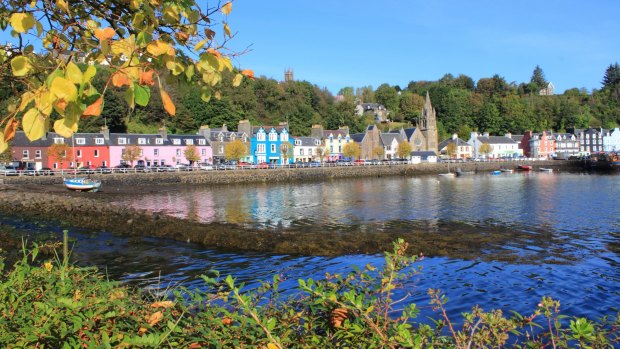
The colourful old town of Tobermory.
"When I'm here at Duart, I always look forward to greeting my clans people who have often made long and arduous journeys to see where their families began," he says, inviting members of our group who are MacLean descendants to sign the special visitors' register.
Duart Castle is a lonely, romantic place, silently guarding the Sound of Mull – a total contrast to the brightly coloured fishing village and tourist drawcard, Tobermory, Mull's capital at the other end of the sound.
Regarded as one of the most picturesque and cheerful towns in Scotland, Tobermory is a favourite location for filmmakers (it was the setting for the British children's TV series, Balamory). It has a distillery, a marine visitors centre, lots of art galleries, pubs, restaurants, cafes and craft shops.
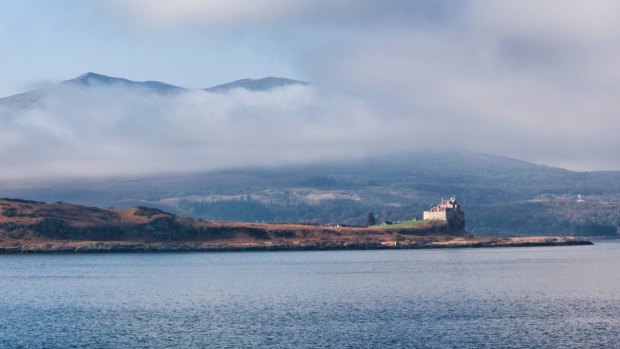
The morning mist lifts from Duart Castle.
But I make a beeline for Tobermory's excellent little museum midway along the harbour front because Mull has a special significance for Australians: it was the breeding ground for Lachlan Macquarie, the fifth governor of NSW, sometimes called "the Father of Australia".
Macquarie wasn't actually born on Mull, but on nearby Ulva – one of a string of little islands a couple of nautical miles off Mull's Atlantic coast. But by the time Lachlan was 14, his family had moved to a small farm at Oskamull on the Mull mainland, and he's buried here on the island.
My plan had been to visit Macquarie's mausoleum, near Salen, midway between Tobermory and Duart. But when I ask for instructions on how to get there, the museum's helpful curator (a true Scot) tells me not to waste my money. "It's a small, squat, dreary memorial," he says. "You'd be better off saving the £50 it'll cost you by taxi, and buying yourself a decent lunch."
I take his advice, partly because there is so much about Macquarie's life and career at the museum. The curator explains that Macquarie chose the site for his mausoleum himself in April 1824 – two years after he left Sydney for the last time – feeling that the end was nigh. Sure enough, he died that year, and was buried in Mull.
The lengthy inscription, composed by his widow Elizabeth with the aid of a local minister, concludes: "His respect for the ordinances of religion and the ready assistance which he gave to every charitable institution, the unwearied assiduity with which he sought to promote the welfare of all classes of the community, the rapid improvement of the colony under his auspices, and the high estimation in which both his character and government were held, rendered him truly deserving of the appellation by which he has been distinguished, The Father of Australia."
According to author Fiona Marsden, Macquarie began redeveloping Salem as a model village around 1816 while still in Sydney, "taking on characteristics of plans realised or thwarted in NSW".
He planned a distillery, a water mill, a post office and a change of name to Port Macquarie. Sadly, he died without being able to make a start on any of them.
The museum illustrates much of Macquarie's stunning rise from farm boy to Lion of the Enlightenment, so I toast him with a pint of the Terror of Tobermory, made by the Isle of Mull Brewing Company.
MacLeans and Macquaries – they're a hardy breed on Mull.
TRIP NOTES
MORE
FERRY
Both Tobermory (tobermory.co.uk/) and Duart Castle (duartcastle.com/) are served by ferries from Oban, Lochaline and Kilchoan. See Caledonian MacBrayne ferry information, calmac.co.uk/destinations/mull
TOUR
Captain's Choice's next trip to Scotland in 2018 is a 17-day Following Tracks through Celtic Lands on the Belmond Royal Scotsman train. It visits Aberdeen, Kyle of Lochalsh, Rothiemurchus Forest, Dunkeld, Dundee and Edinburgh before setting off on the Belmond Grand Hibernian Train from Dublin, visiting Cork, Killarney, Galway and Westport. From $35,950 a person twin share, departing Australia on June 8, 2018. Call 1300 162 587. See captainschoice.com.au
Steve Meacham travelled as a guest of Captain's Choice.
Sign up for the Traveller Deals newsletter
Get exclusive travel deals delivered straight to your inbox. Sign up now.